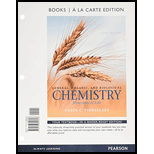
Concept explainers
Interpretation:
Each of the given chemical compounds should be identified as a part of the citric acid cycle, electron transport chain or both.
Concept introduction:
► Citric acid cycle includes various reactions which occur in living cells during aerobic respiration. In this cycle, acetyl-CoA is oxidized for releasing carbon dioxide and energy in the form of ATP.
► Electron transport chain is the last step of aerobic respiration and includes a sequence of
To identify: Each of the given compounds as a part of citric acid cycle, electron transport chain or both.
Answer to Problem 23.51UTC
Solution:
(a) Citric acid cycle.
(b) Electron transport chain.
(c) Both citric acid cycle and electron transport chain.
(d) Electron transport chain.
(e) Citric acid cycle.
Explanation of Solution
(a) Succinate is a chemical species formed from Succinyl CoA during citric acid cycle. It produces fumarate after its reaction with succinic dehydrogenase.
For this reason, succinate is a part of citric acid cycle.
(b) is a chemical species that produces complex III along with cytochrome c reductase (-cytochrome creductase complex) and helps in transfer of electrons.
For this reason, is a part of electron transport chain.
(c) FAD (Flavin adenine dinucleotide) is a cofactor of redox reactions. It helps in controlled redox reactions in both citric acid cycle and electron transport chain and releases energy as ATP.
For this reason, FADis a part of both citric acid cycle and electron transport chain.
(d) Cyt c (Fe2+) is a type of hemeprotein found in mitochondrial membrane. It participates in electron transport chain and helps in transfer of electrons.
For this reason, cyt c (Fe2+) is a part of electron transport chain.
(e) Citrate is a chemical species formed from acetyl-CoA during citric acid cycle. It produces cis-aconitate after its reaction with aconitase.
For this reason, α-ketoglutarate is a part of citric acid cycle.
Each of the given chemical compounds is identified as a part of citric acid cycle, electron transport chain or both.
Want to see more full solutions like this?
Chapter 23 Solutions
General, Organic, and Biological Chemistry: Structures of Life, Books a la Carte Edition; Modified MasteringChemistry with Pearson eText -- ValuePack ... Chemistry: Structures of Life (5th Edition)
 ChemistryChemistryISBN:9781305957404Author:Steven S. Zumdahl, Susan A. Zumdahl, Donald J. DeCostePublisher:Cengage Learning
ChemistryChemistryISBN:9781305957404Author:Steven S. Zumdahl, Susan A. Zumdahl, Donald J. DeCostePublisher:Cengage Learning ChemistryChemistryISBN:9781259911156Author:Raymond Chang Dr., Jason Overby ProfessorPublisher:McGraw-Hill Education
ChemistryChemistryISBN:9781259911156Author:Raymond Chang Dr., Jason Overby ProfessorPublisher:McGraw-Hill Education Principles of Instrumental AnalysisChemistryISBN:9781305577213Author:Douglas A. Skoog, F. James Holler, Stanley R. CrouchPublisher:Cengage Learning
Principles of Instrumental AnalysisChemistryISBN:9781305577213Author:Douglas A. Skoog, F. James Holler, Stanley R. CrouchPublisher:Cengage Learning Organic ChemistryChemistryISBN:9780078021558Author:Janice Gorzynski Smith Dr.Publisher:McGraw-Hill Education
Organic ChemistryChemistryISBN:9780078021558Author:Janice Gorzynski Smith Dr.Publisher:McGraw-Hill Education Chemistry: Principles and ReactionsChemistryISBN:9781305079373Author:William L. Masterton, Cecile N. HurleyPublisher:Cengage Learning
Chemistry: Principles and ReactionsChemistryISBN:9781305079373Author:William L. Masterton, Cecile N. HurleyPublisher:Cengage Learning Elementary Principles of Chemical Processes, Bind...ChemistryISBN:9781118431221Author:Richard M. Felder, Ronald W. Rousseau, Lisa G. BullardPublisher:WILEY
Elementary Principles of Chemical Processes, Bind...ChemistryISBN:9781118431221Author:Richard M. Felder, Ronald W. Rousseau, Lisa G. BullardPublisher:WILEY





